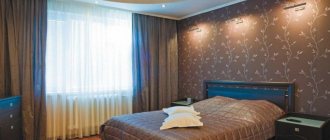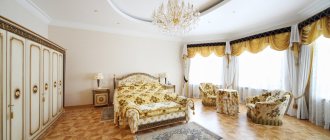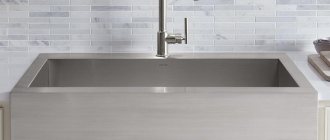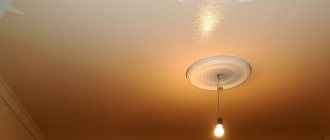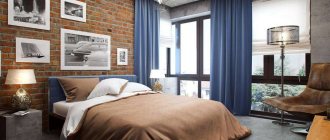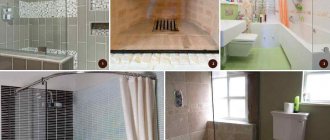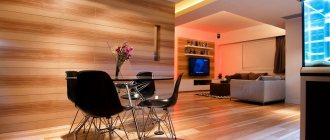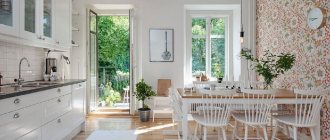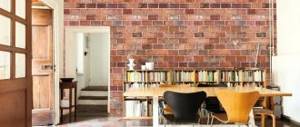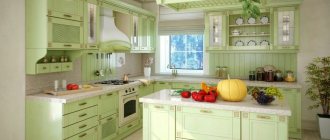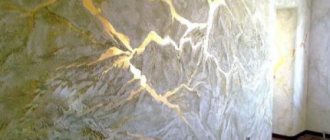Dyeing, whitewashing
Whitewashing is now used less frequently than painting. Light shades are good for small rooms and visually enlarge them. Before whitewashing the surface, it must be prepared - leveled. The disadvantages include rapid crumbling, which requires constantly moistening the room and updating the whitewash every year.
Painting is one of the budget ways to make the ceiling beautiful. Paints with different compositions are suitable for finishing:
- latex (quick drying, cannot be washed with soapy water, can hide minor surface irregularities, lose color in direct sunlight);
- water-based (low cost, easy to apply, wash with soap and water)
- silicone (they do not wear off for a long time due to wet cleaning, you can safely clean it 5000 times, then they will slowly begin to wear out);
- acrylic (resistant to humidity, sunlight, hides minor surface irregularities).
Cleaning, plastering and priming are required before painting. The composition is applied with rollers, brushes, or a spray gun. Wash surfaces with a soapy solution and dishwashing detergent. This method has positive and negative sides.
Positive:
- low cost;
- absence of strong aromas;
- quick application (if leveling is not required);
- can be used in any room (except for water-based composition).
Negative:
- inability to disguise wires and cables;
- for application, a smooth base is required so as not to highlight unevenness;
- some types of paint can be used for no more than 3 years, because of poor quality production (determined by price).
Advantages and disadvantages of different ceilings
Tensioner
It is a canvas that is fixed to a profile made of plastic or aluminum and is located under the main ceiling. If you don’t want to level, prime and paint the ceiling, hide the defects under PVC film or fabric. At the same time, a seamless fabric covering is considered more durable than PVC fabric. Before installation, all cracks must be sealed with sealant. And the prototype of modern tension structures can be considered a ceiling draped with fabric in Ancient Greece.
Advantages:
- It easily withstands flooding from neighbors above, which means you don’t have to worry about the wallpaper, furniture and the ceiling itself getting damaged.
- Fireproof, environmentally friendly, does not fade from sunlight.
- Withstands a load of 100 kg/m2. Can hide wires, pipes, beams.
- Wide choice of colors and textures (suede, gloss, satin, matte). Any design (photo printing) can be applied to PVC film. If desired, such a ceiling can be made multi-level (for example, in the form of an arched vault).
- The fabric version does not require individual adjustment, has no seams, roll width is up to 5 m, length is at your request. Takes up only 2 cm of room height. A “floating” ceiling with lighting around the entire perimeter looks impressive.
- Fast installation. You can install a ceiling of medium complexity in half a day. The canvas is stretched before repairing the walls, but after all rough dusty operations and after electrical installation.
- Warranty – 10 years.
A stretch ceiling with a mirror surface makes the room taller. Suitable for a room in a classic style
Flaws:
- When welding PVC strips, a seam remains on them, which can be noticeable on mirror sheets with a large area.
- Cannot withstand negative temperatures.
- Lamps in suspended ceilings have a power limit. Incandescent lamps – 50 W, halogen – 35 W. Otherwise, the ceiling will overheat, stretch and sag.
- High cost (from $35 1 m2) and the possibility of damage from a sharp cutting object.
Stretch ceilings can have different textures. The glossy surface is interesting for its mirror effect, which makes the ceiling “higher”. The matte texture does not give reflections, has deep color saturation, and is a universal option for a room of any style. And the satin ceiling appears pearlescent white due to its smooth texture and good reflective properties.
Plasterboard (GKL)
A building material made from two layers of cardboard with gypsum paste inside is called gypsum board. Drywall sheets are placed and secured onto the wooden or metal profiles that create the frame of the structure. The glass wool placed inside acts as a sound insulator. This ceiling is a type of suspended ceiling.
Advantages:
- Allows you to bring any design idea to life and create a ceiling of any configuration and size, including multi-level relief.
- Possibility of installing halogen lamps.
- Durability and reliability. Sturdy yet lightweight design.
- If desired, this ceiling can be repainted.
- Does not emit harmful chemicals.
- It has fire-fighting properties due to a layer of air and special fillers.
Gypsum board ceiling for a room in a minimalist style
Flaws:
- If the structure is installed in the kitchen, you need to purchase an electric hood. Otherwise, steam and soot will contaminate the surface, and the ceiling will have to be painted every year.
- It is impossible to wash the gypsum plasterboard coating, as well as to use it in wet rooms, that is, this option is not suitable for the bathroom.
- The water holding capacity is 50 l/m2 (less than the tension one). After flooding, drywall loses its appearance and requires replacement (the frame remains the same).
- It is advisable to use with a room height of 3 m. The design “eats up” a space of 5-20 cm, depending on its shape.
- It is problematic to carry out high-quality installation on your own; you will have to call in specialists, which increases the cost of repairs.
Plastic panels (PVC)
This is a modern finishing material, it can be glossy or textured, with a width from 25 to 40 cm and a variety of colors (including patterns).
When purchasing, choose panels with a large number of stiffeners - they are stronger and more durable. Check the panels for flexibility and find out if they are easily connected to each other (the joints should be neat). With slight compression, cracks should not appear on the surface of the material. If your actual ceiling is flat, the panels can be glued in place using liquid nails, but most often they are installed on a metal or wood frame.
Siding is a type of finishing made of PVC or wood. Initially it was intended for external surfaces, therefore it has higher strength characteristics.
The siding looks quite presentable and can be washed. Good option for the bathroom
Advantages:
- The ceiling material does not ignite, is not affected by fungus, and does not emit toxins. Therefore, this type of finishing can be used in bathrooms and toilets.
- Does not fade under the influence of sunlight and artificial light, the coating can be washed with detergents.
- If it is necessary to zone a room (for example, a kitchen), laying siding will help to separate the work area from the dining area.
- Electrical wiring, ventilation and sewer pipes can be installed above the sheathing. Moreover, access to communications will be available, because the tiles can be easily disassembled.
- Relatively low cost of the material (about $2-6 per 1 m2).
- Easy to install, which means you can install such a ceiling yourself and save on the work of a professional.
Disadvantage of PVC panels:
- Fragility. Requires careful handling during operation. An accidental small impact with a tool can leave a mark.
The original solution is wooden ceiling beams. They fit perfectly into the interior of such a living room.
Bleached or Dyed
Eco-friendly and breathable ceiling. If you follow the technology, you can achieve a smooth, neat, white surface. No special professional skills required. Before whitewashing, washing, leveling and priming are done. Painting with water-based paint is a good, low-budget way to update the ceiling.
Foam tiles
Interesting ceiling finishing options can be made with foam ceiling tiles. It is glued to the surface of the ceiling. It is suitable for all rooms, even with high humidity. It comes in different shapes and thicknesses. The form should fit the tiles together well to create a solid surface. Therefore, slabs are produced in the shape of a rectangle, square, rhombus, hexagon.
Tiles are produced not only in white, there are many shades of delicate and bright. You can also paint them yourself with water-based paint. You can make this kind of ceiling yourself - just glue the tiles with construction adhesive. It insulates heat and sounds well and is not expensive. But during use in kitchens it turns yellow, and in bathrooms it becomes moldy. Therefore, it is better to choose a different material for the kitchen and bathroom.
Types of ceilings according to the material used
Now let's look at what types of ceilings there are according to the type of material used. It should be taken into account that the basis for some finishing materials can be tension, suspended or hemmed ceiling structures.
Painted
Whitewashing or painting the ceiling surface is the simplest and most common type of finishing due to its accessibility. Whitewashing is done using chalk or lime, and interior paints are used for painting.
Advantages of painting the ceiling surface:
- acceptable price;
- speed and ease of work (suitable for do-it-yourself);
- some types of paints are allowed to be used in places with high humidity;
- The coating is washable.
The disadvantages of painting include fading of the surface and cracking of the paint layer. In addition, before painting, the base surface needs careful preparation and leveling. Removing the old finishing layer is quite difficult.
Plastic
Plastic ceiling panels are distinguished by a large selection of colors and surface textures. They create a continuous monolithic coating thanks to tongue-and-groove joints at the ends.
Their advantages include the following:
- the ability to choose colors to match the style and color of the room;
- simplicity and speed of installation;
- good heat and sound insulation characteristics;
- resistance to high humidity conditions;
- the material is not susceptible to damage by microorganisms;
- does not need finishing like drywall.
The disadvantage of PVC products is that they support combustion and release toxic substances during a fire. In addition, with temperature changes and their elevated values, the panels can become deformed, causing the seams between individual elements to become noticeable.
Plasterboard
Drywall is used to make single-level coverings that resemble traditional concrete ceilings, and complex multi-tiered structures with lighting and different finishing options.
There are various types of finishes for plasterboard ceilings:
- They can be painted with interior paints. In this case, the surface needs to be puttyed, sanded and primed. Only after this is it allowed to paint.
- Such surfaces are often covered with wallpaper. In this case, there is no need to putty the entire ceiling; it is enough to treat only the seams and places where the screws are installed with putty solution. After this, the coating is primed and covered with wallpaper.
- Also, self-adhesive film, polystyrene or ceramic tiles, and mosaics are glued to the plasterboard surface.
The advantages of ceiling wallpaper include a large selection of colors, textures and surface imitation options. The reasonable price of the material and the absence of waste during the work are additional advantages. However, some types of wallpaper cannot tolerate high humidity conditions. In addition, this finishing option is not durable.
Stretch (PVC) ceilings
Stretch ceilings are installed in all rooms. It is a PVC film or synthetic fabric that stretches very evenly horizontally across the ceiling. Many people are interested in what types of suspended ceilings there are:
- glossy;
- matte;
- satin;
- with imitation of mirrors, metal, fabric, etc.
There are other options for suspended ceilings that differ in color. They can be plain or multi-colored with different textures. To obtain an unusual design, they can make multi-level compositions or solder films of different shades. There are models with sound insulation and antibacterial components.
Often interesting ideas are brought to the design of the ceiling. For example, a perforated ceiling. For them, 2 canvases are used: the first is basic (located under the ceiling); the second is decorative (located closer to the floor) with patterned slots and geometric shapes.
Interesting! For a more impressive look, perforated ceilings are equipped with internal built-in lamps.
PVC film ceilings can be washed with special liquids or dishwashing detergent and water. If your neighbors accidentally flooded you, you can call the company that installed the canvas and ask them to drain the water. After this procedure, the film will return to its previous position.
Tension fabric does not have a wide range of colors, like PVC film. But they can be repainted 4 times. And they do not become deformed due to a decrease in ambient temperature. For care, you will need to immediately clean the stains without water (it causes streaks), and clean with a vacuum cleaner. It is advised not to install such a ceiling in rooms with a risk of flooding (bathtub, toilet, kitchen).
Advantages of suspended ceilings:
- service life up to two decades;
- no signs of sunburn for up to 10 years;
- can be quickly installed without damaging the rest of the room;
- many colors and textures suitable for any interior design;
- does not burn;
- slightly reduces the room (from 3cm to 5cm);
- models made of polyvinyl chloride retain water when flooded;
- You can disguise cables and wires.
Design disadvantages:
- impossibility of self-installation;
- PVC film can be easily torn;
- canvases made from poor raw materials release toxins;
- if the temperature is below 5 degrees, the material will become hard;
- road material for simple and multi-level surfaces;
- after installation it may smell like synthetics for several days;
- It is more difficult to install the light, and there are limitations on lighting power.
Experts believe that when determining which suspended ceilings are best installed in an apartment, you need to take into account the well-being of the residents. If you have a lot of allergy sufferers, then make a fabric ceiling. If everything is fine with health, then it is better to make it from PVC film to protect the property from flooding.
Which ceiling is best for a room?
The living room is the front room of the apartment.
In it, household members get together, greet guests, communicate with friends, and resolve business issues. The design of such a room should be functional and elegant. The living room does not have the same humidity as the bathroom, so the choice of materials is a little wider. You can use original lighting in the style of a starry sky, gypsum stucco, polyurethane ceiling decorations, designer paintings, stretch ceilings with photo printing and, of course, all types of ceilings available in wet rooms. A multi-level suspended ceiling with original lighting will look very advantageous here. For living rooms designed in a minimalist style, stretch or painted ceilings are suitable.
Dropped ceilings
Many owners are interested in what kind of ceilings would be best to install in an apartment? Suspended structures are currently popular. They easily level the surface, hide communications, some types can be installed independently, are durable, you can replace several elements rather than replacing the entire structure, there are a lot of finishing materials.
But they “steal” the height, especially noticeable in small apartments, some structures allow steam to pass through, which contributes to the appearance of mold, it does not protect against leaks, self-installation requires careful work and accurate calculations.
Aluminum slatted ceiling
This ceiling does not deteriorate from humidity, so it is installed in kitchens, bathrooms, and hallways. The comb strips are secured to the ceiling surface or sheathing, and then the slats are snapped onto them. A slatted ceiling can be with a gap (when there is space between the slats) or without a gap. Aluminum slats have many advantages:
- you can install built-in light;
- moisture resistance;
- hides wires, cables, pipes;
- many textures and colors;
- When adding insulation, it insulates noise.
But a slatted ceiling may develop a patina; by adding built-in lamps, noise insulation reduces the height of the room; Careful installation is required so as not to bend the slats.
Lining
A beautiful wooden ceiling in an apartment is suitable for Provence, country, loft, eco-style. This design of ceilings in an apartment has many positive features. For example, wood is a beautiful and environmentally friendly material, resistant to temperature changes and with a long service life.
Unfortunately, wood swells from high humidity, so for the bathroom you need to treat the boards well with antiseptic agents, heat-resistant wax or natural oils.
Laminate finishing
Another non-standard material from which you can beautifully decorate suspended ceilings in an apartment is laminate. It imitates wood well, gives rooms coziness, isolates extraneous sounds and retains heat. Laminate is very durable, beautiful, safe for health, and has many colors and textures. The only negative is that it can collapse from moisture.
Cassette system
Unusual types of suspended apartment ceilings are cassette systems. Cassettes (square plates) are attached to the frame. Moreover, the materials for cassette ceiling finishing can be different: glass, plaster, metal, mineral fiber, wood. Cassettes are painted in different colors and given different textures. Spotlights can be installed behind glass panels to produce soft diffused light.
Drywall
This material has three layers: the front and back sides are made of construction cardboard, and in the middle there is a gypsum mixture. After installation, different finishes are applied to the front side (paint, wallpaper, plaster, PVC film, foam tiles).
Depending on the resistance to humidity and fire, different types of drywall are installed:
- Conventional plasterboard is used for dry rooms.
- Fire-resistant gypsum plasterboard is installed in fire hazardous areas, for example in the kitchen or living room (if a fireplace is installed).
- Moisture-resistant gypsum plasterboard is installed for rooms with high humidity and painted with a moisture-resistant solution.
- Moisture-resistant GKLVO is resistant to water and fire.
Drywall has many advantages. For example, it is quickly mounted and dismantled, creates a smooth surface without plastering, is suitable for hiding pipes, cables, wires, you can get a multi-tiered structure, and is often mounted for installing spotlights.
But plasterboard sheets cannot stop the flood, reduce the height of the room, and are subject to deformation and loss of original color. It is not recommended to install sheets in new houses, because after shrinkage they may crack and you will have to re-do the ceiling.
Ceilings in a private house
Ceiling for a house made of wooden lining
Due to the impossibility of considering all the structures in the house that are in use, we will pay attention to only two types of ceilings - wooden lining and plasterboard construction. In addition, we will also consider insulation methods, which are similar for all suspended structures .
Insulation
- Suspended ceilings for a country house can be insulated with mineral wool, polystyrene foam, penoplex and polyethylene foam, but the first two names are most in demand - mineral wool and polystyrene foam (see Types of plasterboard ceilings: design features).
Foiled mineral wool
- Mineral wool is made from melts of three main materials - glass (glass wool), basalt (stone wool) and blast furnace slag (slag wool). In addition, cotton wool can be covered on one or both sides with a layer of foil, which serves as a heat reflector and significantly increases the thermal insulation qualities of the material. Products are produced either in bales or in rolls .
Foam sheets of various thicknesses
- Polystyrene foam is a product of foaming plastics and is formed into square panels 100x100cm for household use. The thickness of the sheets is 20,30,40,50 and 100mm. Foam plastic also differs in compression density, so panels come in 15 kg/cm2 and 25 kg/cm2 (fifteenth and twenty-fifth density) (see Foam ceiling tiles, types and installation instructions).
Insulation of a suspended ceiling with mineral wool
- We are looking at how to make pre-insulated ceilings in a house and in this photo we see that mineral wool is placed between the frame slats. Insulation is also done using polystyrene foam in the same way, but insulation can also be installed before making the frame .
Ceiling insulation with foam plastic
- The insulation can be placed directly on the U-shaped strip hangers, and then metal profiles or slats can be mounted to them. This method of insulation is relevant if there is a main ceiling and when installing a suspended structure, a ceiling cavity is formed (see Ceiling in a bathhouse - choosing the best method of insulation!).
Roof insulation
- You can insulate the ceiling in a cottage or any house by installing insulation directly under the roof. The power of the thermal insulation layer mainly depends on its thickness, but also on the waterproofing or foil coating.
Insulation from the attic
- You can also insulate ceilings in a private house from the attic side . Here, in fact, any type of insulation is suitable, because it is simply applied on top, on the ceiling. In such a situation, sometimes they simply cover the attic floor with expanded clay, and if the layer is more than 3 cm, then you are provided with thermal protection.
- You can also insulate ceilings in a private house from the attic side . Here, in fact, any type of insulation is suitable, because it is simply applied on top, on the ceiling. In such a situation, sometimes they simply cover the attic floor with expanded clay, and if the layer is more than 3 cm, then you are provided with thermal protection.
Wooden lining ceiling
Wooden lining ceiling
- Imagine that you need to make a ceiling structure in a house from rounded logs. Somehow it naturally suggests itself that a wooden finish would be appropriate there, and for obvious reasons we will now consider a suspended structure made of wooden lining .
Water level
- First of all, you need to determine the level at which the suspended ceiling frame will be mounted. At this stage, we can either raise the ceiling structure in the house or lower it - everything will depend on the height of the frame. Therefore, using a water level, we place marks around the perimeter and use a chockline (painting cord) to mark a control line along them.
Tape U-shaped hangers
- The most convenient way to adjust the height of the ceiling in the house is with the help of U-shaped tape suspensions (peshki), which are fixed either to the main ceiling or to the beams. The second option is considered taking into account the fact that the ceiling beam in a country house, as a rule, is not leveled along the plane, therefore both the level and height are regulated by suspensions .
- If the ceiling has concrete floors, then the suspension is installed on two plastic dowels with screws, and if there is a wooden base, then with ordinary self-tapping screws. The distance between the pawns should be no more than 50-60cm, and if the frame rail is deformed, then install additional hangers as the profile bends.
Hanging frame made of wooden slats
- For the frame, a 20x40mm, 20x50mm, 25x40mm or 25x50mm rail is used. You can, of course, use thicker profiles, but there is no point in this, and besides, this will be an unreasonable consumption of building materials. The distance between the profiles on the frame for wooden lining will be from 40 to 50 cm, even if there are heavy lamps on the ceiling - this will be enough.
- The outer profiles of the frame are attached close to the wall, and sometimes instead of slats they use 50x50mm timber and fix it not with hangers to the ceiling, but with long screws to a vertical plane. To fix the wooden profile, wood screws 25mm long are used. The protruding ears of the dewlaps are bent to the sides .
- The ceilings in the cottage will be even if you assemble an even frame. It is very difficult to level each profile separately, so it is easier to stretch a nylon thread under the frame, screwing it with self-tapping screws to the outer slats.
The lining is attached to the frame with clamps
- Metal clamps are used to fasten the lining to the frame. These fasteners are supplied with nails 20mm long, but nailing the fastener with them is very inconvenient and not entirely reliable. Usually the clamp is screwed to the frame with a 25mm self-tapping screw.
Installation of wooden lining on the ceiling (the frame is covered with a hydraulic barrier)
- The first panel is screwed to the frame with screws along the very edge so that they can later be covered with a baguette or ceiling plinth. After all, how can you repair the ceilings in a house if you don’t decorate the perimeter with something? So don’t try to fit the panels too tightly to the wall - the gap will be covered by the finishing material.
- To install the last lining, you need to determine its width. To do this, take measurements in three or four places and transfer them to the panel. The distance may not be the same due to the uneven wall.
Gaps around the perimeter of the ceiling are covered with baguette or plinth
- If you have already decided how to line the ceiling structure in your house and have settled on wooden lining, now select the material with which you will close the gap around the perimeter. Most often, either a wooden plinth or a baguette is used, and the latter is sometimes sewn onto both planes. Thus, around the perimeter we get something like an unfolded corner.
- If the ceiling height in a country house does not allow you to hang a chandelier, and you will use overhead lamps, do not forget that wood is a flammable material. To prevent the body of the lighting fixture from getting too hot, use light bulbs up to 50W or install an asbestos gasket under the lamp.
Plasterboard ceilings
Drywall between false beams
- The optimal height from the floor to the ceiling surface in a house is 250-270 cm, so the frame for a plasterboard suspended structure must be oriented towards these dimensions. If there are false beams in the room, then they can be lower, but the plane of the suspended ceiling should still be approximately at this level so that there is no feeling of heaviness (very low ceilings “press”).
The control line is beaten off with a paint cord
- In the same way as in any other suspended ceiling, we use a chockline to mark the control line for the level of the frame. But the frame itself for plasterboard ceilings will be slightly different from a wooden structure.
Suspensions on the main ceiling
- Now you need to make markings on the main ceiling for attaching the hangers. Each row should be fixed strictly 50cm from each other, which means that for them you need to use the same chockline to beat off the control line. The distance between the pawns should not exceed 60-70cm.
The CD profile is inserted into the UD profile
- When the optimal ceiling height in the cottage has already been determined and the control line has been marked, we screw the UD profile to the wall. The distance between the fastenings is 40-50cm. The profiles can be joined overlapping, inserting one into the other.
- We continue to cover the topic of how to repair the ceiling in a house and move on to installing CD profiles. The elements are cut to the required length (5mm shorter than the distance from wall to wall) and placed in the UD under the hangers, without being fixed to them.
To level the frame, a nylon thread is pulled
- Under the metal hanging frame, as well as under the wooden frame, a nylon thread is stretched. To prevent the profiles from dragging it down with their sagging, each of them needs to be raised above the plane, bending the ears of the middle suspension under it. Then you level each CD along a thread, screwing it to the pawns with special small metal screws.
- Sometimes you have to screw two screws on one side to remove the play, otherwise the frame will “rattle.” The same screws are used to connect the CD to the UD.
GCR needs to be lifted by two people
- Before sheathing the ceiling surface in a plasterboard house, find an assistant to lift the sheets to the frame. It’s not even about the weight of the gypsum board, but about its size, because it is 120x250cm, and it’s almost impossible to lift a sheet of that size alone, because it will break.
- An average of 60 metal screws 25mm long are consumed per sheet. They are screwed in 30cm apart. To prevent the cap from falling into the sheet, use nozzle No. 2 for drywall. After installing the gypsum board, you can begin to putty.
Recommendation. Above the suspended ceiling you will definitely have wiring for lighting and possibly communication lines . All wiring should be packaged in a tubular corrugated cable duct and secured to the main ceiling or beams.
Advice. When purchasing small metal screws for a frame, check their quality using nozzle No. 2. Put a screw on it and place the nozzle in a horizontal position with a slope of 20⁰-25⁰ towards the screw. If it doesn’t fly off, it means the quality is good and it will be easy to work with.
Ceiling tiles
The most budget-friendly type of ceiling decoration, excluding usually painted surfaces, is gluing ceiling tiles. It can be smooth and textured.
The most common and cheapest is polystyrene foam tiles. However, there is no need to talk about the environmental friendliness of this material. It is not suitable for rooms with high humidity, since foam plastic easily absorbs moisture, and for rooms with sudden temperature changes.
On sale you can also find tiles made of wood, metal and mirror, their price increases accordingly. Mirror tiles visually raise the ceiling, fill the room with additional light, and have reflective properties.
The base for gluing the tiles must be fairly level, only minor irregularities and cracks are allowed. Tiling a ceiling is a quick and relatively clean process. It is used for finishing ceilings in both residential and non-residential premises.
Cheap ceilings in the room: decorative film
Of course, you can save money on stretch ceilings. Buy cheaper film, do not hire specialists, but stretch the film yourself. Yes, such a ceiling will be cheaper, but it’s not without reason that they say that the miser pays twice - this is just such a case. A cheap stretch ceiling can only exist in two cases: either film from Russian or Chinese manufacturers, or a crude fake. You need to be careful: it’s not so easy to distinguish.
To understand that you have purchased low-quality products, you just need to pay attention to several factors:
- The initial price may differ from the final price several times;
- “Specialists” will not have the necessary skills and qualifications;
- There will be no necessary quality certificates;
- The material will be significantly inferior in all characteristics - this is noticeable even to the naked eye.
If you still want suspended ceilings, you can still save money. For example, order the simplest design, without photo printing and a bunch of levels. Many companies hold various promotions and provide discounts. You can contact the experts for advice - they will help you choose an economical, but nevertheless high-quality option.
Important points
- Ideally, before starting work, a design project of the room is created. In this case, you can guarantee that the ceiling will harmoniously combine with the walls, floor, and furniture. On the Internet you can download a ready-made project drawing of a suspended ceiling.
- Determine for which room you are choosing finishing material. For living rooms, the main condition is environmental friendliness (ask for quality certificates from the seller). For bathroom and kitchen ceilings there are additional requirements: moisture resistance, good performance.
- Regardless of what kind of ceiling you want to make in your apartment, you need to think about lighting. Light is important not only from a functional point of view, it is an important decorative element, creates the right atmosphere, and focuses attention on certain areas of the room. You need to outline where the lamps will be located before installing the ceiling covering.
We conclude that the ideal option for a living room or bedroom is a suspended ceiling or plasterboard. PVC panels will be appropriate in the corridor, bath and toilet. It is advisable to use siding on the balcony. And painting or whitewashing are popular as low-cost finishing methods.
Video: installation of a PVC ceiling
Video: gypsum board ceilings
You have started renovating a room, or maybe the entire area of an apartment or house. You have to decide on the ceilings, their appearance, materials, color. With the advent of many new building materials, the task has become more complicated.
It’s rare that anyone stops at regular whitewashing or even painting.
I would like to bring both beauty and unusual design into my home by combining different materials for ceilings.
What criteria are used to determine its appearance? Which ceiling is better to make?
Let's look at the main types of ceilings and ceiling systems, their features, labor intensity and cost of performing the work.
Which ceiling is better to choose?
So, let's sum it up. The cheapest way to make ceilings is in three ways:
- plaster and paint the ceiling with acrylic interior paint;
- cover with PVC tiles;
- make suspended ceilings from plastic panels.
The first option is more labor-intensive, but suitable for any room. In the bathroom and kitchen it is enough to paint it with waterproof paint. As a result, such a surface is not afraid of moisture and can be washed periodically.
PVC tiles are suitable for living spaces and kitchens. True, in the kitchen, textured tiles are more difficult to clean from soot. It is not suitable for rooms with high humidity.
Plastic panels are often used for rooms with high humidity: in bathrooms and kitchens, as well as in utility rooms.
Suspended plasterboard ceilings are suitable for all rooms. In the bathroom and kitchen, it is enough to make them from moisture-resistant material (GKVL) and paint them with washable paint. More attention needs to be paid to sealing the joints between the sheets. But as practice shows, such ceilings have proven themselves well.
Stretch ceilings can also be used in all rooms of the apartment and house. They are not afraid of moisture and are easy to care for. The glossy surface makes it possible to visually enlarge a small bathroom or kitchen space. Such ceilings are not susceptible to rotting and mold. They are durable. A large selection of colors and patterns make it possible to make the premises unique and very cozy.
Gone are the days when the ceiling could only be whitewashed or painted; today there is a wide choice in this regard.
After you have decided to make a renovation, you need to come up with a design for the room. Of course, the design of the ceiling is not the least important.
Deciding which ceiling to make is not an easy one because a lot depends on it.
A small room will visually look larger if you choose the right ceiling, and a large room with the right choice will look more comfortable. Before choosing a ceiling covering, it is necessary to evaluate the base base and take into account the presence of unevenness. The room where the ceiling will be made also plays an important role.
The wallpaper is pasted after the primer has dried. Under no circumstances should you stick newspaper under the wallpaper, otherwise over time the paint from the newspaper will bleed through the wallpaper.
Compared to whitewashing and painting, wallpapering is a fairly clean task, which is undoubtedly considered an advantage. Ceiling wallpaper retains its attractive appearance for 5-6 years, of course, under proper operating conditions and if the ceiling wallpaper is of high quality. By choosing this method, you can reliably hide small cracks and seams that may be visible during plastering and painting. In most cases, such wallpaper is denser than regular wallpaper; it is made of two layers of thick paper glued together, with embossing or foam vinyl on top. Due to their thickness, such ceiling wallpaper perfectly hides all the unevenness of the ceiling; they do not require a perfectly prepared surface.
As for the cost of ceiling wallpaper, it depends on the manufacturer. Such ceilings will look good in a children's room; you can use cheerful shades for this. It should be noted that this method of finishing the ceiling does not involve much hassle, since there is no need to repair uneven areas and wash off the paint.
For the ceiling you need to purchase special ceiling wallpaper or non-woven wallpaper.
However, there is also a drawback to some types of ceiling wallpaper, which is that they cannot be washed. Therefore, if such ceilings are made in a children's room, then it is better to choose ceiling wallpaper that is washable.
To apply wallpaper you will need the following tools:
- swing hand;
- wallpaper knife;
- roller for applying glue;
- plastic spatula;
- roulette;
- scissors.
Return to contents

